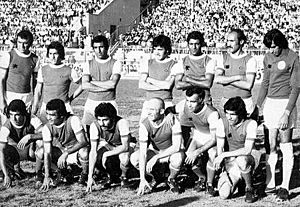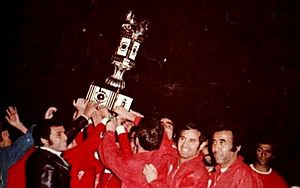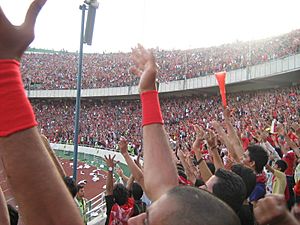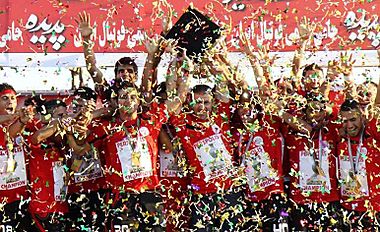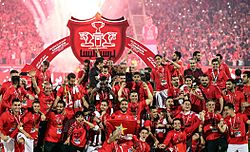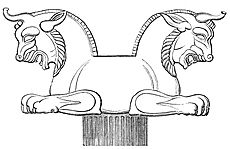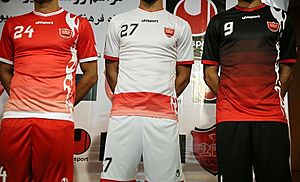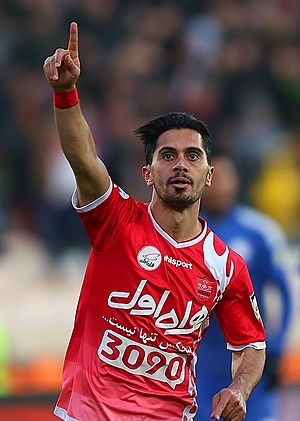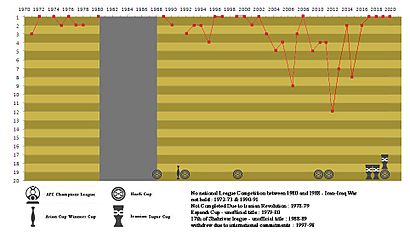Persepolis F.C. facts for kids
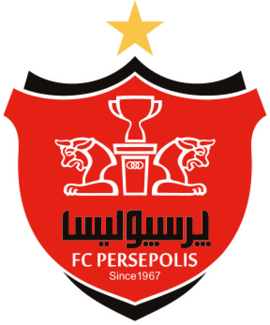 |
||||
| Full name | Persepolis Football Club | |||
|---|---|---|---|---|
| Nickname(s) | The Red Army Tehran Reds |
|||
| Short name | PRS | |||
| Founded | November 1963 as Persepolis Amateur (Bowling) team March 21, 1967 as Persepolis Football team |
|||
| Ground | Azadi Stadium | |||
| Capacity | 78,116 | |||
| Owner | Persepolis Athletic and Cultural Club (Bank Shahr: 30% Bank Mellat: 20% Tejarat Bank: 20% Bank Saderat Iran: 5.175% MSY: 5.158% Refah Bank: 5% EN Bank: 5% Public Shareholders: 9.667% – IFB: PSPP1) |
|||
| President | Reza Darvish | |||
| Head coach | Vahid Hashemian | |||
| League | Persian Gulf Pro League | |||
| 2024–25 | Persian Gulf Pro League, 3rd | |||
|
||||
Persepolis Football Club is a professional football team from Tehran, Iran. They play in the Persian Gulf Pro League, which is Iran's top football league. Persepolis is part of a larger sports club called Persepolis Athletic and Cultural Club. Until April 2024, the club was owned by the Iranian government. Now, a group of six Iranian banks owns most of it (85%). About 10% of the club's shares are available for people to buy on the stock market.
Persepolis was started in 1963 by Ali Abdo. Since 1968, they have been in the top division of Iranian football. Their home stadium, Azadi Stadium, has been used since 1973. They have a big rivalry with another Tehran team, Esteghlal. This match, called the Tehran derby, is one of the most watched football games in Asia.
The Asian Football Confederation says Persepolis is one of the most popular football clubs in Asia. Many of the highest-attended matches in the AFC Champions League have been played by Persepolis. They have even had over 100,000 fans at four of their Champions League games.
Persepolis has won a record 16 Iranian league titles. They have also won seven Hazfi Cups, five Super Cups, and the 1990–91 Asian Cup Winners' Cup. Many famous players have played for the club, including Ali Karimi, Ali Daei, Vahid Hashemian, and Mehdi Mahdavikia. Ali Parvin, who played for 18 years (1970-1988), is often called the club's greatest player.
Contents
History of Persepolis F.C.
Shahin F.C. (1942–1967)
Shahin was a football club started in 1942 by Dr. Abbas Ekrami, a teacher. He created the club with his young students. Their motto was: "Ethics first, education second, sports third."
Shahin helped many talented players become famous. Some of these players, like Parviz Dehdari, Homayoun Behzadi, and Hossein Kalani, also played for the Iran national football team. Shahin was very popular in the 1960s. However, the Football Federation Islamic Republic of Iran (FFIRI) and a sports magazine felt threatened by its popularity. Because of this, Shahin F.C. was closed down on July 9, 1967. After Shahin was dissolved, many of its players looked for new teams.
Early Years (1963–1969)
The Persepolis Athletic and Cultural Club was founded in 1963 by Ali Abdo. He was a champion boxer who had returned to Iran from the United States.
Persepolis F.C. began the 1968 season with Dehdari as their manager. Under Dehdari, many former Shahin players joined Persepolis. This helped the team keep its popularity. At first, the team was not very strong and played in Iran's second division. One of their best players back then was Mahmoud Khordbin.
The club played a friendly match with Jam Abadan, a strong team at the time. After this game, the rest of the Shahin players joined Persepolis. In 1968, no league competition was held because many teams had been dissolved. Instead, a tournament with 44 teams took place. Persepolis finished at the top of its group, along with Pas, Taj, and Oghab.
The next year, Persepolis became the first Iranian club to play in the Asian Champion Club Tournament in Thailand. They were eliminated in the group stage.
Takht Jamshid Cup (1969–1979)
In 1969, Mahmoud Khayami, who helped start the car company Iran National, made a deal with Persepolis. He signed almost all the former Shahin players to his new team, Paykan Tehran F.C.. Paykan won the championship that year. However, these players returned to Persepolis at the end of the season.
In 1971, Persepolis won its first ever championship in the Iranian League. They finished the season with 13 wins and only 1 draw in 14 weeks. In 1972, Ali Abdo announced that Persepolis was Iran's first professional football club. The club did not play in the local league that year and only competed against foreign teams. A few months later, it became an amateur club again.
In 1973, the Takht Jamshid Cup was created. Persepolis won the first Cup and won it again in 1975. That year, Persepolis lost only two out of thirty matches. Persepolis is the most successful club in the Takht Jamshid Cup, winning two titles and finishing second three times.
Success During Tough Times (1979–1990)
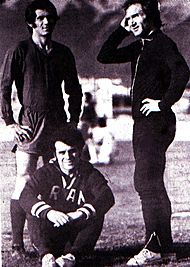
After the Iranian Revolution in 1979, Ali Abdo went back to the United States. Even though Persepolis won the Espandi Cup, the club faced many problems. Many of its old players did not return. The government took over the club's property and put it under the control of the Physical Education Organization.
In 1981, the Physical Education Organization wanted to change the club's name. But the club's officials, players, and fans did not agree. As a protest, the team did not show up for a match against Homa in the Tehran league. They lost 3–0, and Homa won the championship. In 1986, the club was taken over by another group and renamed Azadi (meaning "freedom"). The players said they would not play if the name changed. After a short time, the club was given back to the Physical Education Organization.
On February 16, 1987, the Physical Education Organization renamed the club Pirouzi (meaning "victory"). The players agreed to this name. However, fans still called the team Persepolis. On April 10, 2012, the club chairman announced that the official name was Persepolis again.
In the 1980s, the club mostly played in the Tehran League and various knockout tournaments. Persepolis was very successful and stayed popular. They won the Tehran League five seasons in a row. During this time, Ali Parvin was both a player and the manager.
Revitalization (1990–2001)
The 1990s were a great time for the team. They won four league championships and two Hazfi Cups. They had a strong team and many fans. At one point, more than six Persepolis players were starters for Iran's national team.
The team won the national championship in the 1995–96 season. They were 10 points behind another team but ended up 6 points ahead. They won the league again the next season, also finishing 6 points ahead. In the same year, they reached the semi-finals of the Asian Champions' Cup but lost to a Korean team. Persepolis finished third, beating an Iraqi team.
The team did not play in the National League the next season. This was because many players were on the national team, and the club also had to play in the Asian Champions' Cup. Poor planning by football officials caused this problem. Persepolis also did not have much luck in the Asian Champions' Cup, losing in the semi-finals again.
Many people believe the Persepolis teams from 1996–97 and 1997–98 were among the best Iranian clubs ever. Famous national team players like Ahmadreza Abedzadeh, Ali Daei, Mehdi Mahdavikia, and Ali Karimi played for the club during those years.
After the World Cup 1998, some of Persepolis' best players moved to European clubs. But Persepolis still had a talented team, with future national team players like Ali Karimi joining. They won the 1998–99 championship and the Hazfi Cup that season. They also won the 1999–2000 league championship. This was their last championship in the Azadegan League era. Most of Persepolis' championships back then were won when Ali Parvin was the manager.
IPL Era (2001–present)
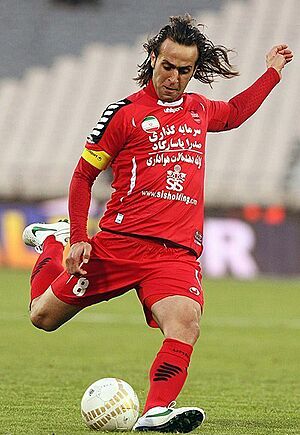
Persepolis joined the Iran Pro League (IPL) when it started in 2001. In the first season, they were in a close race with their rival Esteghlal. On the final day, Esteghlal lost their game, and Persepolis won 1–0 against Fajr Sepasi. This gave Persepolis a one-point lead and the first-ever IPL championship. Persepolis finished third in the 2002–03 season. They also did not get past the group stage in the new AFC Champions League.
When Akbar Ghamkhar became the club chairman, he made changes to improve the team. He made player salaries public, which upset Parvin, who was the highest-paid player. Ghamkhar hired coach Vinko Begović and signed several well-known players. Persepolis started the 2003–04 season well, but things got worse. Begović left, and German manager Rainer Zobel took over. Ghamkhar was replaced by Hojatollah Khatib, who brought Parvin back as the club's technical director. The club finished fifth in the 2004–05 season.
The club faced big money problems because of spending decisions made in earlier years. Persepolis finished the 2005–06 season in ninth place, their lowest ever. Ali Parvin left the club in February 2006 after fans were angry following a 4–2 loss.
Khatib resigned as chairman. Mohammad Hassan Ansarifard was chosen as the new chairman. Arie Haan became the new manager and helped the team reach the 2005–06 Hazfi Cup final. But he was fired just before the 2006–07 season began. Turkish manager Mustafa Denizli joined the team on August 17, 2006. Denizli's first match was the Hazfi Cup final, which the team lost. Winning this cup would have helped the club get into the Asian Champions League and receive money.
The club did not win the Hazfi Cup in 2007, losing in the semi-finals. They finished third in the 2006–07 IPL. Denizli left the club after Ansarifard resigned in June 2007.
Afshin Ghotbi: The "Emperor" Era
Habib Kashani became the club chairman in June 2007. He chose Afshin Ghotbi as the head coach for the 2007–08 season. Ghotbi promised to lead Persepolis to the IPL championship. The club started the IPL with a 3–2 win. Persepolis was undefeated until the 17th round, when they lost 2–1.
Later, FIFA took away six points from Persepolis because of unpaid wages to former players. This put Persepolis behind Sepahan in the standings. Near the end of the season, two players were removed from the team for bad behavior. Kashani and Khordbin both had heart attacks during the season. Persepolis managed to cut Sepahan's lead to just two points by the last game. In that final match, Persepolis defeated Sepahan with a goal in the 96th minute by Sepehr Heidari. This win, in front of over 110,000 fans, earned Persepolis their second IPL championship and a spot in the Asian Champions League. Persepolis, Ghotbi, and Mohsen Khalili won "Team," "Manager," and "Player" of the year awards.
Ghotbi's contract ended, and he decided to leave the club. His assistant, Hamid Estili, was close to becoming manager. However, Kashani and other club officials resigned due to problems with the Iran Physical Education Department. Dariush Mostafavi was then chosen as chairman. Mostafavi promised to bring Ghotbi back. They reached a deal, and Ghotbi signed a two-year contract on July 4, 2008. But Ghotbi had many problems with Mostafavi and resigned on November 19, 2008. He later became the head coach of the Iran national football team.
After Ghotbi left, his assistant Afshin Peyrovani became the temporary head coach. He led the team for 11 matches. Then, Nelo Vingada, a former manager for Portugal and Saudi Arabia, took over. Vingada's contract ended at the end of the season.
Ali Daei's Years
After Vingada left, Zlatko Kranjčar was hired as manager, but he was quickly replaced by Ali Daei, a former Persepolis and Iran national football team captain. At the end of the 2009–10 season, Persepolis finished fourth in the league but won the Hazfi Cup. In the Hazfi Cup final, Persepolis beat Gostaresh Foolad Tabriz 4–1 overall. This qualified them for the 2011 AFC Champions League.
In the 2010–11 season, Persepolis finished fourth in the league and was eliminated in the group stage of the 2011 AFC Champions League. At the end of the season, Persepolis won the 2010–11 Hazfi Cup again. Under Ali Daei's leadership, Persepolis won two trophies in a row for the first time in 13 seasons.
After Daei resigned, several managers took over, including Hamid Estili, Mustafa Denizli, Manuel José, and Yahya Golmohammadi. Golmohammadi led Persepolis to the final of the Hazfi Cup, but they lost on penalties. After the Hazfi Cup, Golmohammadi announced he would not manage Persepolis the next season.
Daei returned to the club and signed a three-year contract before the 2013–14 season. Under Daei, Persepolis finished second, just 2 points behind the champions. This earned Persepolis a spot in the AFC Champions League after two years. After a bad start to the 2014–15 season, Daei was fired and replaced by Hamid Derakhshan.
Branko Ivanković's Years
On April 5, 2015, Hamid Derakhshan resigned as head coach. The next day, Branko Ivanković, a former manager of the Iran national football team, became the new head coach.
On May 15, 2015, Ivanković won his first Tehran derby with a 1–0 victory. A few days later, Persepolis beat Al-Hilal 1–0 in the first game of the AFC Champions League round of 16. However, they lost the second game 3–0 and were eliminated.
For the 2015–16 season, Hadi Norouzi became the team captain. Persepolis also signed new players like Ramin Rezaeian and Jerry Bengtson.
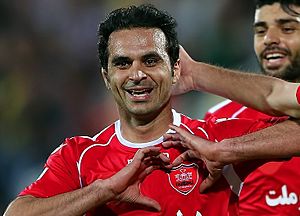
On October 1, 2015, team captain Hadi Norouzi sadly passed away at age 30 from a heart attack. After his death, Persepolis started playing much better and won several games in a row. They moved into the top 3 teams. After a big 4–2 win against Esteghlal in the Tehran derby, the team reached first place. However, they dropped to third place after a loss. Persepolis won their final game of the season, but it was not enough. Another team also won, and Persepolis finished second in the 2015–16 Persian Gulf Pro League.
Before the 2016–17 season, Persepolis added more national team players like Alireza Beiranvand and Jalal Hosseini. Persepolis started the season strong and stayed near the top. They set records for the fewest goals given up and most points earned after 17 weeks. On April 15, 2017, Persepolis became the champions of the season with three weeks left to play. This was their third championship in the Persian Gulf Pro League and their 10th overall. Persepolis also won the Persian Gulf Pro League in 2017–18 and the Super Cup.
On May 30, 2017, Persepolis reached the quarterfinals of the AFC Champions League for the first time in its current format. They beat a Qatari club 1–0. Persepolis then beat a Saudi club 5–3 overall to reach the semi-finals, where they lost to Al Hilal. In 2018, Persepolis made it to the AFC Champions League finals but lost 2–0 in the first game. They drew 0–0 in the second game, losing the final to a Japanese team. On May 16, 2019, Ivanković led the team to another Persian Gulf Pro League championship. He left the club after four years, having won a record seven trophies as a foreign coach.
Team Colors and Logo
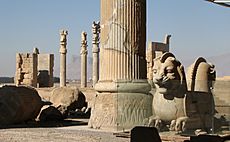
Persepolis Football Club is named after Persepolis, which was the capital of an ancient Persian empire. The club's logo uses parts of designs from that ancient city. The first logo had the Faravahar, an old Persian symbol with falcon wings. After using it on their shirts for a few years, the team stopped. In the mid-1980s, they created a new logo based on an image from a column at Apadana. This image showed two bull heads on one body, with a cup on top and Olympic symbols below. The bull represents being productive in ancient Persian beliefs, and the cup means championship.
The team changed the logo again in the mid-1990s to a more modern look. The Olympic rings were removed, and the cup became clearer. This version was used until 2004. Then, the team brought back the Olympic rings and replaced the bulls with the Homa, a mythical bird from Persian architecture. In the 2011–2012 season, the club released its current logo. This logo combines the older design within a red shield shape and includes the name Persepolis in both Persian and English.
One of Persepolis' nicknames is Sorkhpoushan, which means "the reds." This comes from their traditional home uniform, which is mostly red. Since the club started, their home kit has usually been a red shirt, red (sometimes black or white) shorts, and red socks. White and black colors are also seen in their uniforms. In the early 1970s, players wore black shorts. White shorts were used in the late 1970s, and red shorts became common in the 1980s.
In the 2006–07 season, fans saw the team wear red-and-white striped shirts. The team's away uniform is usually white.
| Historical kits | ||||||||||||||||||||||
|---|---|---|---|---|---|---|---|---|---|---|---|---|---|---|---|---|---|---|---|---|---|---|
|
Stadiums and Training Facilities
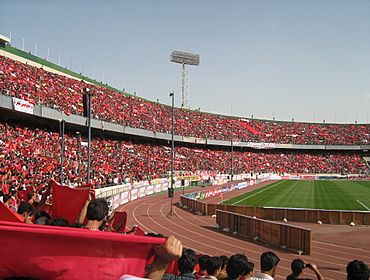
When Persepolis was first created, the football team did not have its own stadium. However, it did have gyms, swimming pools, and bowling alleys. Ali Abdo bought land in Tehran and built a stadium there. It was called Apadana Stadium. Persepolis only played one game there because the seating was not well organized. Other Iranian clubs also did not want to play there. So, Persepolis used the stadium as a training ground instead.
Around the mid-1970s, Ali Abdo had to sell much of the club's property to keep it running because of money problems. He sold Apadana Stadium in 1975. Apadana Stadium is now called Rah Ahan Stadium. After the Iranian Islamic Revolution in 1979, the government took over the club's properties. The original club headquarters were burned down, and Abdo returned to the United States.
Azadi Stadium
Before Azadi Stadium was built in 1971, Persepolis played its matches at Shahid Shiroudi Stadium. Since 1973, Azadi Stadium has been Persepolis' home ground. The team has played almost all their home games there. The only exception was the 2002–03 season, when they played most home matches at Tehran's Takhti Stadium while Azadi was being renovated.
In mid-2006, Persepolis thought about buying Shahre Ghods Stadium. But the deal did not happen because of Persepolis' money problems and the stadium being far from the city center.
Persepolis has played against Esteghlal 85 times in Azadi Stadium. Esteghlal has won 25 times, Persepolis has won 21 times, and there have been 39 draws. This derby is known as the biggest in Asia for teams from the same city.
Derafshifar Stadium
Derafshifar Stadium is where Persepolis trains and has its youth academy. The complex includes training areas, a hotel, and swimming pools. There is also a sauna, steam room, weight rooms, a restaurant, meeting rooms, and offices. The stadium was given to Persepolis in 2013.
Shahid Kazemi Stadium
Persepolis became the owner of Shahid Kazemi Stadium in late 2016. This stadium can hold 15,000 people. It is used for training sessions and friendly matches. The complex has a sauna, steam room, weight room, restaurant, and meeting room. In January 2017, the club announced plans to improve the complex. They planned to add a second grass field, parking lots, and a cafeteria. They also planned to upgrade the meeting room, locker room, gym, and swimming pool.
Persepolis University
Persepolis opened the first Iranian sports university in 2013. This university has 600 students. It offers courses in thirteen different areas. These include football and futsal coaching, fitness, sports reporting, and match commentary.
Persepolis TV and Internet Radio
In June 2013, Persepolis started Persepolis TV. It was available on satellite television. The channel closed in October 2013. It was relaunched during the 2017–18 season.
The team also has an internet radio station on its official website. This station offers recordings that people can download.
Food and Drink
The club started selling energy drinks in 2013. The club also opened three restaurants to help with its finances and attract fans. The first restaurant opened in Shiraz. As of July 2025, all three restaurants have closed.
Rivalries
Tehran Derby
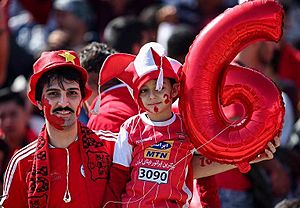
Persepolis plays in the Tehran Derby against Esteghlal. This rivalry comes from an older rivalry between Shahin and Taj. After Shahin players joined Persepolis, the club became very popular. Their rival, Taj (meaning "crown"), was supported by the Shah of Iran. In June 2008, World Soccer magazine called this derby the most important in Asia and the 22nd most important in the world. Persepolis holds the record for the biggest win in this derby, beating Esteghlal 6–0 on September 7, 1973.
Persepolis vs. Sepahan
Persepolis also has a rivalry with Sepahan, a team from Isfahan. Both clubs were connected to Shahin in the past. One team signed most of Shahin's players early on, and the other was Shahin F.C.'s branch in Isfahan. The rivalry became strong again in the early 2000s. This was when Isfahan's teams, Sepahan and Zob Ahan, started winning the IPL and the Hazfi Cup.
Persepolis vs. Tractor
Persepolis started a rivalry with Tractor S.C. when Tractor returned to Iran's top football league after eight years.
Players
First-team squad
|
|
Reserve Squad
|
|
Other players under contract
|
Out on loan
|
Retired Numbers
| No. | Player | Position | Persepolis debut | Last match | Ref. |
|---|---|---|---|---|---|
| 24 | MF/FW | 24 October 2008 | 25 September 2015 |
On October 6, 2015, the club retired the number 24 jersey. This was done to honor Hadi Norouzi, who passed away at age 30.
Notable Players
For notable players see List of Persepolis F.C. players.
For details on former players see Category:Persepolis F.C. players.
Club Captains
| # | Name | Nat | Career in Persepolis |
Captaincy | Shirt No. |
|---|---|---|---|---|---|
| 1 | Hamid Jasemian⚱ | 1968–69 | 1968–69 | 5 | |
| 2 | Aziz Asli⚱ | 1968–71 | 1969–71 | 1 | |
| 3 | Buyuk Vatankhah | 1968–69 1970–74 |
1971–72 | 6 | |
| 4 | Homayoun Behzadi⚱ | 1967–68 1969–75 |
1972–74 | 10 | |
| 5 | Jafar Kashani⚱ | 1968–69 1970–75 |
1974 | 4 | |
| 6 | Ebrahim Ashtiani⚱ | 1968–69 1970–76 |
1974–76 | 2 | |
| 7 | Ali Parvin | 1970–88 | 1976–88 | 7 | |
| 8 | Mohammad Mayeli Kohan | 1976–90 | 1988–89 | 19 | |
| 9 | Mohammad Panjali | 1977–87 1989–94 |
1989–94 | 5 | |
| 10 | Farshad Pious | 1985–88 1989–97 |
1994–96 | 17 | |
| 11 | Mojtaba Moharrami | 1988–97 | 1996–97 | 8 | |
| 12 | Hossein Abdi | 1987–2000 | 1997–2000 | 12 | |
| 13 | Ahmad Reza Abedzadeh | 1994–01 | 2000–01 | 1 | |
| 14 | Afshin Peyrovani | 1993–96 1997–04 |
2001–04 | 5 | |
| 15 | Behrouz Rahbarifar | 1994–03 2004–06 |
2004–06 | 20 | |
| 16 | Karim Bagheri | 1996–97 2002–10 |
2006–10 | 6 | |
| 17 | Sheys Rezaei | 2003–08 2009–12 |
2010 | 13 | |
| 18 | Sepehr Heidari | 2007–11 | 2011 | 3 | |
| 19 | Ali Karimi | 1998–01 2008–09 2011–13 |
2011–12 | 8 | |
| 20 | Mehdi Mahdavikia | 1995–98 2012–13 |
2012–13 | 2 | |
| 21 | Mohammad Nouri | 2010–15 | 2013–15 | 14 | |
| 22 | Hadi Norouzi⚱ | 2008–13 2014–15 |
2015 | 24 | |
| 23 | Alireza Nourmohammadi | 2010–16 | 2015–16 | 20 | |
| 24 | Jalal Hosseini | 2012–14 2016–22 |
2016–22 | 4 | |
| 25 | Omid Alishah | 2013–17 2018– |
2022– | 2 |
⚱ Passed Away
Hall of Fame
The players listed below are honored in the Persepolis F.C. Hall of Fame:
 Ebrahim Ashtiani (DF)
Ebrahim Ashtiani (DF) Homayoun Behzadi (FW)
Homayoun Behzadi (FW) Hamid Jasemian (DF)
Hamid Jasemian (DF) Hossein Kalani (FW)
Hossein Kalani (FW) Jafar Kashani (DF)
Jafar Kashani (DF) Mahmoud Khordbin (FW)
Mahmoud Khordbin (FW) Fereydoun Moeini (MF)
Fereydoun Moeini (MF) Ali Parvin (MF)
Ali Parvin (MF) Kazem Rahimi (MF)
Kazem Rahimi (MF) Hadi Tavoosi (GK)
Hadi Tavoosi (GK) Büyük Vatankhah (DF)
Büyük Vatankhah (DF) Reza Vatankhah (DF)
Reza Vatankhah (DF)
Managers
Notable Managers
The table below shows Persepolis managers who have won important titles or had a big positive effect on the team.
| Name | Nat | Period | Trophies |
|---|---|---|---|
| Parviz Dehdari | 1968–69 | Tehran Hazfi Cup: 1969 Runner-up Asian Club Championship Qualification: 1969 Winner |
|
| Alan Rogers | 1971–76 | Iran local league: 1971–72 Winner Takht Jamshid Cup: 1973–74 Winner – 1974–75 Runner-up |
|
| Buyuk Vatankhah | 1976 | Takht Jamshid Cup: 1975–76 Winner | |
| Ali Parvin | 1982–93 1998–03 2005–06 |
Persian Gulf Pro League: 2001–02 Winner Azadegan League: 1998–99, 1999–00 Winners – 1992–93, 2000–01 Runners-up Qods League: 1990 Runner-up Tehran Province League: 1983, 1987, 1988, 1989, 1990, 1991 Winners – 1982, 1984, 1992 Runner-up Tehran Hazfi Cup: 1982, 1987 Winners – 1981 Runner-up Hazfi Cup: 1988, 1992, 1998–99 Winners Asian Cup Winners' Cup: 1991 Winner – 1993 Runner-up Asian Club Championship: 1999–2000 semi-finals (3rd place), 2000–01 semi-finals (3rd place) |
|
| Stanko Poklepović | 1995–97 | Azadegan League: 1995–96, 1996–97 Winners Asian Club Championship: 1996–97 semi-finals (3rd place) |
|
| Mustafa Denizli | 2006–07 2011–12 |
Hazfi Cup: 2005–06 Runner-up | |
| Afshin Ghotbi | 2007–08 | Persian Gulf Pro League: 2007–08 Winner | |
| Ali Daei | 2009–11 2013–14 |
Persian Gulf Pro League: 2013–14 Runner-up Hazfi Cup: 2009–10, 2010–11 Winners |
|
| Branko Ivanković | 2015–19 | Persian Gulf Pro League: 2016–17, 2017–18, 2018–19 Winners, 2015–16 Runner-up Hazfi Cup: 2018–19 Winner Super Cup: 2017, 2018, 2019 Winners AFC Champions League: 2017 semi-finals, 2018 Runners up |
|
| Yahya Golmohammadi | 2012–13 2020–24 |
Persian Gulf Pro League: 2019–20, 2020–21, 2022–23 Winners, 2021–22 Runner-up Hazfi Cup: 2022–23 Winner, 2013 Runner-up Super Cup: 2020, 2023 Winner AFC Champions League: 2020 Runners up |
Personnel
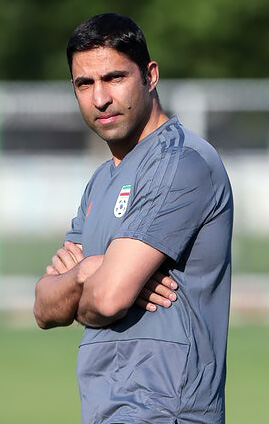
Technical Staff
| Position | Staff |
|---|---|
| Head Coach | Vahid Hashemian |
| First-team coach | Karim Bagheri |
| Assistant coaches | Amir Hossein Peiravani |
| Fitness and Athletic Coach | Jose Augusto Losada Benítez |
| Assistant Fitness coach | Saman Eskandari |
| Goalkeeping coach | Emilio Álvarez |
| Assistant Goalkeeping coach | Javad Bagheri |
| Analyzers | Mehrdad Khanban Siamak Tehrani |
| Match Analyst | |
| Head of the medical committee | DR Farid Zarineh |
| Club doctor | DR Alireza Ghalyayi |
| Physiotherapist | Ali Azam Moadi |
| Academy director | Mohsen Khalili |
| U21 Head coach | Mahmoud Ansari |
| U19 Head coach | Mehdi Atalou |
| U16 Head coach | Farzad Ashoubi |
| U14 Head coach | Hassan Khanmohammadi |
| Team Manager | Afshin Peyrovani |
| Women Team Manager | Hoda Khosh Bayan |
| Media Officer | Alireza Ashraf |
| Director of International Relations | Amir Ali Hosseini |
Last updated: 11 June 2022
Source: Persepolis F.C.
Management
| Office | Name |
|---|---|
| Chairman | Reza Darvish |
| Board secretary | Ahad Mirzaei |
| Board members | Mohammad Akhoondi Siamak Jelveh Mehdi Hemmati Moghaddam Ahad Mirzaei Peyman Haddadi |
Last updated: 1 July 2023
Source: isna.ir
Honours
⚪ Cup Winners
⭕ Super Cup Winners
🏆 Continental champions
| Type | Competition | Titles | Runners-up | Winning Years | Runners-up Years | |
|---|---|---|---|---|---|---|
| Domestic | National | League | 16 | 10 | 1971–72, 1973–74, 1975–76, 1995–96, 1996–97, 1998–99 *, 1999–2000, 2001–02, 2007–08, 2016–17, 2017–18, 2018–19*, 2019–20, 2020–21, 2022–23*, 2023–24 | 1974–75, 1976–77, 1977–78, 1989–90, 1992–93, 1993–94, 2000–01, 2013–14, 2015–16, 2021–22 |
| Hazfi Cup | 7 | 2 | 1987–88, 1991–92, 1998–99*, 2009–10, 2010–11, 2018–19*, 2022–23* | 2005–06, 2012–13 | ||
| Super Cup | 5 | 2 | 2017, 2018, 2019, 2020, 2023 | 2021, 2024 | ||
| Espandi Cup | 1 | – | 1979–80 | – | ||
| Provincial | Tehran Football League | 7 | 4 | 1982–83, 1986–87 ♦, 1987–88, 1988–89, 1989–90, 1990–91, 2011–12♦ | 1970–71, 1981–82, 1983–84, 1991–92 | |
| Tehran Hazfi Cup | 4 | 2 | 1978–79, 1981–82, 1986–87♦, 2011–12♦ | 1968–69, 1980–81 | ||
| Continental | Asian Cup Winners' Cup | 1 | 1 | 1990–91¤ | 1992–93 | |
| AFC Champions League Elite | – | 2 | – | 2018, 2020 | ||
- record
- ¤First ever winners
- * Won League title and Hazfi Cup
- ♦ Won Tehran League title and Tehran Hazfi Cup
- s shared record
Continental History
Individual Honours
Asian Young Footballer of the Year
-
 1997 – Mehdi Mahdavikia
1997 – Mehdi Mahdavikia
Asian Footballer of the Year
-
 1990 – Farshad Pious Runner-up
1990 – Farshad Pious Runner-up 1996 – Ali Daei Runner-up
1996 – Ali Daei Runner-up 1997 – Khodadad Azizi Runner-up
1997 – Khodadad Azizi Runner-up 1997 – Karim Bagheri Runner-up
1997 – Karim Bagheri Runner-up 2012 – Ali Karimi Runner-up
2012 – Ali Karimi Runner-up 2019 – Alireza Beiranvand Runner-up
2019 – Alireza Beiranvand Runner-up
Iran World Cup Captains
-
 1996 – Khodadad Azizi
1996 – Khodadad Azizi
Statistics and Records
Ali Parvin played for Persepolis from 1970 to 1988. He holds the record for most appearances with 341 games. Afshin Peyrovani holds the league appearance record with 209 games, playing from 1993 to 2004. The goalkeeper with the most appearances is Alireza Beiranvand, with 189 games. Among current players, Omid Alishah has the most appearances.
With 149 games, Ali Daei is Persepolis' most capped international player. Farshad Pious is the club's all-time top goalscorer. He scored 153 goals in 211 matches between 1985 and 1998. Persepolis holds the Iranian league records for most titles (16) and most times finishing as runner-up (10). The team also has a record for scoring in 36 games in a row (2014–2015 seasons). They also have a record of 22 games without a loss.
Ownership
Persepolis is owned by the public. Attempts to make Persepolis and Esteghlal private clubs have not worked. This is likely because the government has not wanted to give up control of these very popular clubs. In May 2009, the President said the club would become private. Another attempt in May 2015 failed. It is expected that selling the club to private investors will take a long time. This is mainly due to the club's financial documents and debts. These issues make it hard for the club to be listed on the Tehran Stock Exchange. Shares for the club can be sold on the stock market once all its financial problems are cleared up.
Sponsorship
- Main sponsor: Saba Battery
- Official shirt manufacturer: Merooj
- Sponsor: Tabiat
- Sponsor: Bank Shahr
- Water supplier: Veensu
Shirt Sponsors and Manufacturers
| Period | Kit Manufacturer | Shirt Sponsor | ||||
|---|---|---|---|---|---|---|
| 2015–16 | Uhlsport | T.T Bank | None | Hamrahe Aval | ||
| 2016–17¤ | Joma | Hamrahe Aval | ||||
| 2017–18 | Irancell | |||||
| 2018–19 | Li-Ning | |||||
| 2019–20 | Uhlsport | Irancell | Tourism Bank | |||
| 2020–21 | Tourism Bank | |||||
| 2021–22 | Tourism Bank | Irancell | ||||
| 2022–23 | Irancell | |||||
| 2023–24 | Merooj | |||||
| 2024–25 | Saba Battery | |||||
- ¤ in 2016–17 Persepolis wore Givova kits for the first ten matches of the season.
Supporters
Persepolis is one of the most supported teams in Iranian football. It is estimated that the club has over 40 million fans. The club is based in Tehran and is popular across the country. Persepolis also has many fans in Afghanistan and countries around the Persian Gulf.
Famous Fans
- Mohammad Khatami, Former President of Iran
- Mohammad Reza Khatami, politician
- Sohrab Sepehri, Poet
- Houshang Ebtehaj, Poet
- Davoud Rashidi, Actor
- Khosro Shakibaei, Actor
- Morteza Ahmadi, Actor
- Masoud Kimiai, Director
- Tahmineh Milani, Director
- Masoud Behnoud, Journalist
- Mahmoud Khayami, Founder of Iran Khodro
- Hossein Sabet, Businessman and former owner of Dariush Grand Hotel
- Mohammad Reza Shajarian, Singer
- Homayoun Shajarian, Singer
- Pejman Bazeghi, actor
- Kambiz Dirbaz, actor
Affiliated Clubs
 AC Milan
AC Milan Rubin Kazan
Rubin Kazan Beira-Mar
Beira-Mar Real Madrid
Real Madrid
Reserve Teams
- Persepolis Academy
- Persepolis B
- Persepolis Qaemshahr
- Persepolis Shomal
- Persepolis women
See also
 In Spanish: Persépolis Football Club para niños
In Spanish: Persépolis Football Club para niños




